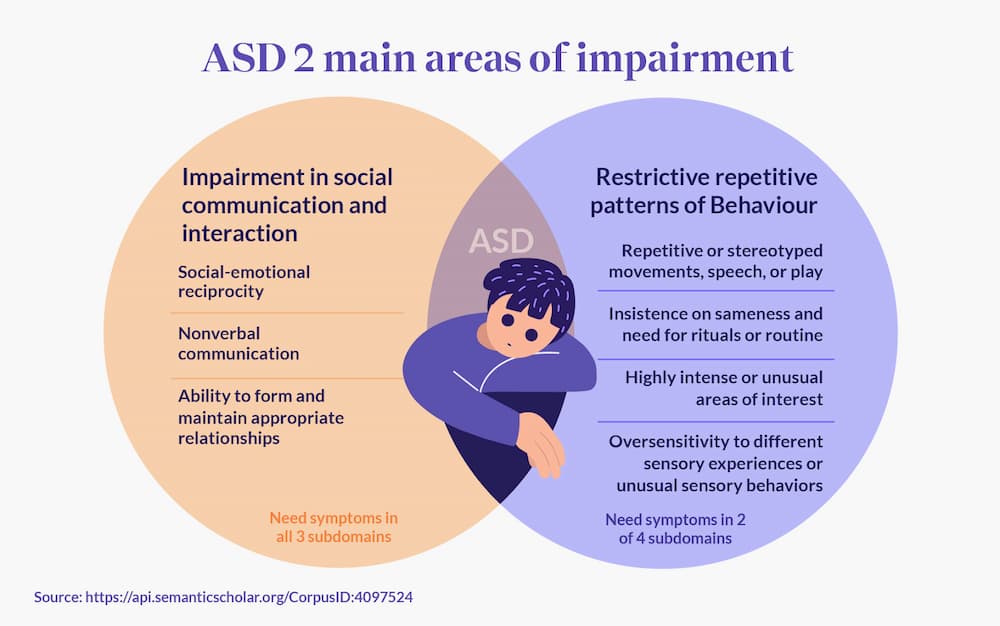Recognizing the Influence of Behavioral Autism on Daily Life and Social Interactions
You could not understand just how deeply behavioral autism impacts life and social interactions. Individuals on the range often navigate a world full of communication obstacles and sensory overload. These difficulties can bring about irritation and isolation, impacting their relationships and overall wellness. Recognizing these subtleties is necessary for promoting supportive atmospheres. What strategies can we carry out to create even more inclusive areas and significant connections? The answers could shock you.
Specifying Behavioral Autism and Its Attributes
Behavioral autism, usually referred to as autism range disorder (ASD), encompasses a series of conditions characterized by difficulties in social interaction, communication, and recurring behaviors. You might observe that people with ASD typically struggle to interpret social cues, which can bring about misconceptions in conversations. They might discover it difficult to develop eye call or involve in tiny talk, making social circumstances really feel frustrating.
Interaction difficulties can show up in numerous ways, from delayed speech development to a choice for making use of fewer words. Repeated behaviors, such as hand-flapping or shaking, can function as coping devices to manage stress and anxiety or sensory overload. These characteristics can greatly affect day-to-day live, making it necessary for you to comprehend and sustain those with ASD. By identifying these traits, you can foster an atmosphere that promotes acceptance and motivates effective interaction, assisting individuals with autism prosper in their everyday communications.
The Spectrum of Autism: Understanding Variability in Actions
Autism spectrum disorder (ASD) isn't a one-size-fits-all medical diagnosis; it differs commonly among individuals. You could observe that some people with ASD display light signs, while others might face much more considerable challenges. This irregularity can materialize in behaviors, rate of interests, and sensory sensitivities. You may encounter individuals who are very verbal and engage quickly in discussions, while others may choose solitary tasks or interact non-verbally.
Furthermore, the way individuals with ASD react to sensory input can vary greatly; some may be bewildered by brilliant lights or loud noises, whereas others grow in boosting settings. The range additionally consists of distinctions in social communications; some people may struggle to analyze social signs, while others browse social settings with loved one convenience. Recognizing this variability is vital, as it aids you value everyone's unique experience and tailor support to their particular demands, cultivating a more inclusive atmosphere for everybody.
Communication Obstacles Dealt With by Individuals With Autism
When you communicate with individuals on the autism spectrum, you may discover their distinct communication challenges. They typically encounter troubles with both spoken and nonverbal hints, which can affect their social communications. Comprehending these barriers is crucial for cultivating much better connections and assistance.

Verbal Interaction Troubles
Numerous individuals on the autism spectrum experience verbal interaction difficulties that can significantly impact their everyday interactions. Your tone, quantity, or speed may not align with social assumptions, creating others to misinterpret your objectives. Identifying these obstacles can aid you and your assistance network develop approaches to enhance communication and foster far better connections with others in your everyday life.
Nonverbal Communication Barriers
Verbal communication isn't the only challenge people on the autism spectrum face; nonverbal communication obstacles can be just as considerable. These difficulties can lead to misunderstandings or misinterpretations of social hints, making communications feel complicated or frustrating. By addressing nonverbal communication, you can locate approaches to boost your social experiences and enhance your general high quality of life.
Social Interaction Effects
Social communications can frequently really feel overwhelming as a result of the special communication difficulties dealt with by people with autism. You may battle with translating social cues, making it tough to understand mockery or body language. This can bring about misunderstandings or unpleasant moments in conversations. Additionally, starting and maintaining conversations may feel difficult, triggering anxiousness in social circumstances. You might choose structured settings, making spontaneous interactions uncomfortable. It's additionally typical to experience problem in taking part in small talk, which can prevent creating brand-new friendships. Acknowledging these difficulties can help you find techniques to boost communication, such as practicing social abilities in safe settings or utilizing visual aids - Autism Therapist. Understanding your needs allows you to navigate social interactions with better confidence and ease.
Social Communication and Relationship Structure in Autism
While building connections can be testing for individuals with autism, understanding their special perspectives and interaction styles can cultivate meaningful links. You might notice that lots of individuals on the range like straight communication and may have problem with social hints or tiny talk. By being simple in your communications, you can assist create an atmosphere where they really feel comfortable.
Involving in shared interests can likewise offer as a bridge to deeper links. Whether it's a hobby, a preferred show, or a common interest, these common threads can open doors to friendship.
Every Day Life Regimen: Navigating Strategies and challenges
Navigating life routines can be specifically testing for individuals with autism, particularly when unforeseen modifications happen. You may locate convenience in having an organized schedule, as it helps you anticipate what's next. When interruptions occur, it's typical to feel anxious or overwhelmed. To navigate these challenges, consider executing visual schedules or checklists. These devices can give quality and confidence.
Establishing a routine that consists of sensory breaks can additionally be helpful. This helps produce an understanding atmosphere.
Last but not least, practice mindfulness techniques to handle stress and anxiousness. Basic breathing workouts or basing techniques can make a considerable distinction. By incorporating these methods, you can boost your daily regimen and reduce interruptions, making life really feel more workable.
Toughness and Abilities of People on the Autism Spectrum
Understanding everyday life regimens is simply one aspect of the autism experience. Several individuals on the autism range possess amazing staminas and abilities that establish them apart.
Additionally, your memory skills often beam, specifically in areas of passion. Autism Behavioral Therapy. This propensity for maintaining info can make you an important source in fields like art, science, or technology. You may additionally exhibit solid visual thinking, enabling you to visualize complex concepts and address troubles artistically
Furthermore, your special viewpoint on the globe can foster compassion and understanding in others, enriching social interactions. Accepting these staminas not only increases your confidence yet additionally assists others appreciate the diverse abilities you give the table.
Producing Comprehensive Settings for People With Autism
Creating comprehensive atmospheres for individuals with autism begins with developing sensory-friendly spaces that accommodate their special requirements. You can likewise promote opportunities for social interaction, aiding to construct links and friendships. By making these modifications, you'll add to an extra welcoming ambience for everybody.
Designing Sensory-Friendly Spaces
While making sensory-friendly rooms, it's important to assess the one-of-a-kind demands of people with autism. Begin by picking relaxing colors and soft lights to develop a soothing environment. Include quiet areas where people can recharge and pull back more helpful hints when bewildered. You'll desire to reduce loud sounds and diversions, using soundproof products or white sound machines to assist keep peace. Think about responsive components like soft fabrics or fidget-friendly things that can offer convenience. Ascertain that areas are adaptable, permitting simple rearrangement to accommodate various tasks. Consist of aesthetic timetables or clear signs to help individuals navigate the space with confidence. By thoughtfully integrating these aspects, you can produce a welcoming environment that supports sensory needs and promotes overall health.
Advertising Social Interaction Opportunities
Designing sensory-friendly rooms not just addresses specific comfort yet likewise Visit Website establishes the phase for purposeful social interactions among individuals with autism. To promote these communications, create inclusive settings that welcome involvement. Arrange organized tasks, like art classes or group games, that encourage collaboration without overwhelming sensory input. Usage aesthetic help and clear interaction to aid everybody involve comfortably. Motivate peer mentoring, coupling individuals with autism with encouraging peers that can guide them via social circumstances. Furthermore, take into consideration holding regular area occasions that celebrate neurodiversity, cultivating approval and understanding amongst all participants. By implementing these techniques, you can boost social chances, helping people with autism develop friendships and enhance their social skills in a secure, welcoming environment.

Regularly Asked Inquiries
Exactly How Can Friends Support Someone With Behavioral Autism?
You can support a friend with behavior autism by holding your horses, listening proactively, and respecting their borders. Take part in activities they appreciate, communicate freely, and create a comfy setting where they really feel valued and understood.
What Resources Are Available for Parents of Children With Autism?
You can check out different sources for parents of youngsters with autism, consisting of support system, academic websites, and regional neighborhood solutions. Connecting with various other parents can additionally supply useful insights and shared experiences to aid browse obstacles.
Can Behavioral Autism Adjustment Gradually?

Yes, behavior autism can transform over time. You could discover shifts in communication, social skills, and behavior as your child expands. Early treatment and support usually play crucial roles in these developmental adjustments.
How Do Sensory Level Of Sensitivities Affect Life?
Sensory level of sensitivities can make day-to-day experiences overwhelming. You may deal with bright lights or loud sounds, causing anxiety or avoidance. Discovering settings that accommodate your requirements can substantially enhance your convenience and total life.
What Prevail Misconceptions Concerning Behavioral Autism?
You may think behavior autism just impacts communication abilities, however it's more facility. Numerous presume people do not have compassion or knowledge, which isn't real. Comprehending these mistaken beliefs aids foster approval and assistance for those on the range.
Behavior go to the website autism, often referred to as autism range condition (ASD), encompasses a variety of problems identified by obstacles in social communication, interaction, and recurring actions.Social communications can often feel frustrating due to the unique communication obstacles faced by individuals with autism.Designing sensory-friendly areas not only addresses individual comfort yet additionally sets the phase for purposeful social communications among individuals with autism. Motivate peer mentoring, pairing people with autism with encouraging peers who can direct them with social situations. By executing these methods, you can improve social opportunities, helping people with autism develop friendships and reinforce their social abilities in a risk-free, welcoming setting.
Comments on “10 Must-Know insights about how an Autism Therapist shapes social growth in autism”